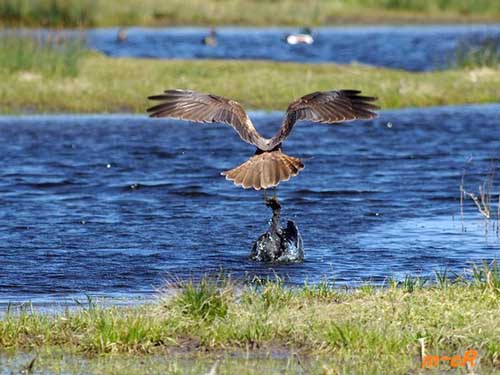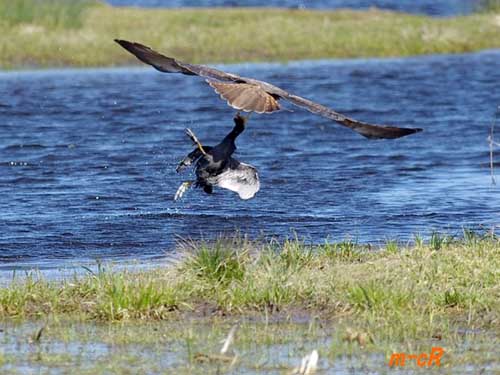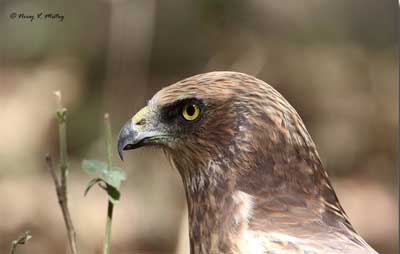
Western Marsh-Harrier
Circus aeruginosus
Accipitriforme Order – Accipitridae Family
BIOMETRICS:
Length: 48-56 cm
Wingspan: 120-135 cm
Weight: 405-670 g
DESCRIPTION:
The Western-Marsh-Harrier is the largest of the four species living in Europe.
It has slender silhouette with long bent wings. Its plumage is dark brown, as the mantel. Male has ashy-grey tail and wings. Its rump is darker than in the other harriers, and it is more robust.
The adult male has brown back and dark reddish-brown head and nape, both streaked of dark brown.
Fr: Busard des roseaux
All : Rohrweihe
Esp : Aguilucho Lagunero Occidental
Ital : Falco di palude
Nd : Bruine Kiekendief
Russe : Болотный лунь
Sd : Brun kärrhök
Photographers :
Audevard Aurélien
OUESSANT DIGISCOPING
Niraj V. Mistry
Photo Galleries
Nicole Bouglouan
PHOTOGRAPHIC RAMBLE
Text by Nicole Bouglouan
Sources :
HANDBOOK OF THE BIRDS OF THE WORLD Vol 2 by Josep del Hoyo-Andrew Elliot-Jordi Sargatal - Lynx Edicions - ISBN: 8487334156
GUIDE DES RAPACES DIURNES – Europe, Afrique du Nord et Moyen-Orient de Benny Génsbol – Delachaux et Niestlé – ISBN : 2603013270
THE HANDBOOK OF BIRD IDENTIFICATION FOR EUROPE AND THE WESTERN PALEARCTIC by Mark Beaman, Steve Madge - C.Helm - ISBN: 0713639601
THE COMPLETE BOOK OF BRITISH BIRDS – Written by “Royal Society for the Protection of Birds” experts - Préface de Magnus Magnusson - Michael Cady- Rob Hume Editors - ISBN: 0749509112
Pájaros de España (JL Beamonte)
BirdLife International (BirdLife International)
Wikipedia (Wikipedia, The Free Encyclopedia)

Throat is dark, chest is reddish and underparts are chestnut, heavily streaked brown. Tail is silver-grey. On the wings, most part of the secondaries is bluish grey, and when the wing is spread, this area forms a large oblique wing bar crossing the wing, contrasting with the extreme black of the primaries and the brown plumage. Legs and talons are yellow with reddish-brown feathered thighs and unfeathered tarsi.
Adult female is more uniform in colour than male. She has creamy head and throat, and fewer streaks than male. Wings and tail are brown. Underparts are dark brown. She is slightly larger than male.
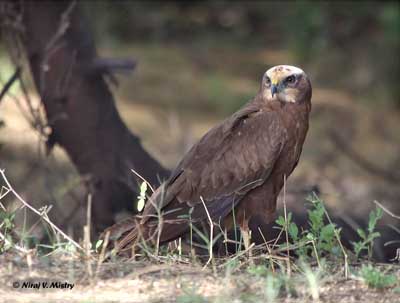
Immature is very dark brown with colour variations on head, nape and back where we can see creamy areas of different sizes. After the first moult, both sexes are similar to the adult female. The Western-Marsh-Harrier reaches its sexual maturity at three years.
VOICE: SOUNDS BY XENO-CANTO
The Western-Marsh-Harrier is very silent outside breeding season. During the courtship displays, the male insistently utters a sad and loud "kiiuu" in flight. Female utters "iiuu" in response. The male’s alarm call is a repeated “chakara-chakara", whereas that of female is a high-pitched "chiuk-chiuk". When an intruder approaches the nest site, a weak "ki-ki-ki" is uttered. The cry is a mono or dissyllabic "psii", and a brief, dry or shrill "kit-kit" or "kiyet" for alarm and high flights.
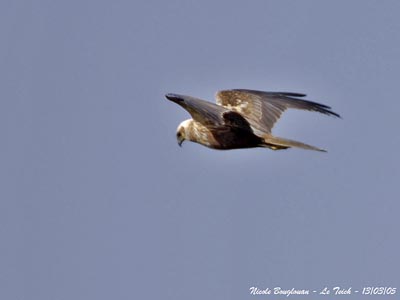
HABITAT:
Fairly common although local, the Western-Marsh-Harrier breeds in marsh reedbeds, sometimes in meadows, lowlands, marshes or lake edges and streams, less often in peat bogs.
The Western-Marsh-Harrier is a typical marsh raptor. In migration, it frequents coasts and open country, but never far from water. It animates lakes and ponds. At other times, it also frequents grassy areas, cultivated lowlands and salt-water marshes.
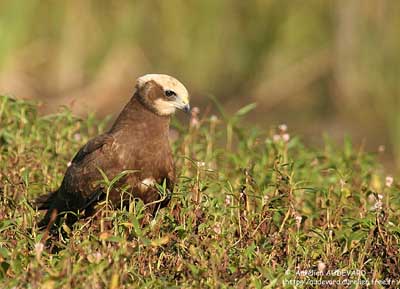
RANGE:
The Western-Marsh-Harrier breeds from Southern Scandinavia, Great Britain and France, Spain and Morocco, and through the most part of Europe and southern Russia.
BEHAVIOUR:
The Western-Marsh-Harrier is an extremely lazy and apathetic raptor, which does not hunt too much. It chooses easy preys like young shore birds, injured or sick birds. While flying for hunting, when it selects a prey, it retains itself in the air and turns, throwing several times into the water to catch a frog or a coot.
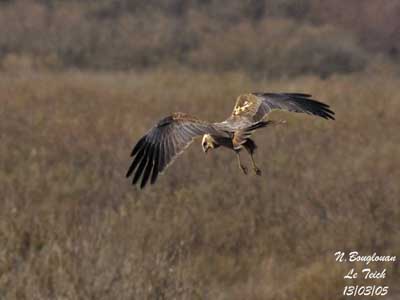
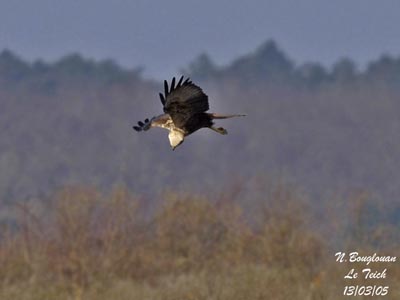
The Western-Marsh-Harrier invariably carries its preys in its left leg’s talons, but despite its size, a lot of preys escape from its claws, or by forming an enormous gathering which attracts other aquatic birds and which end up obliging the raptor to flee by leaving its prey.
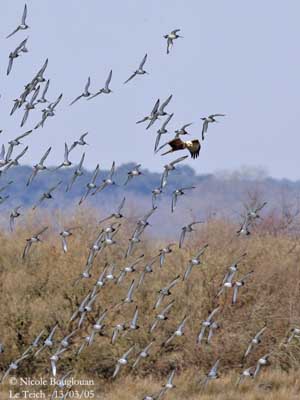
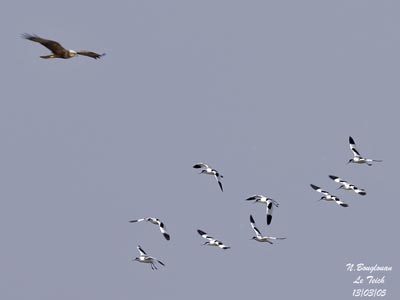
The Western-Marsh-Harrier is gregarious and roosts in groups of up to 5 to 25 individuals where sedges are abundant.
Flight displays include fast dives and ascensions, ending in a descent almost until the ground, with closed wings while calling strongly.
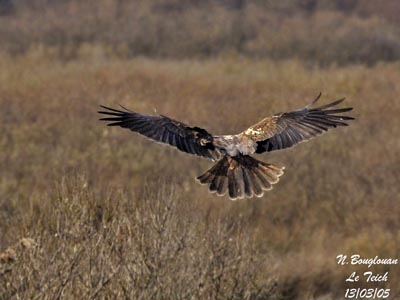
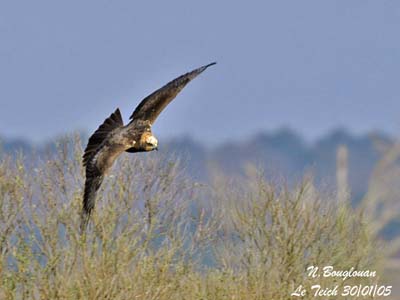
There is a distance minimum to be respected between two nests. Any attempt by another pair for building a nest within 60 meters, causes a reaction of immediate aggressiveness. If an intruder approaches too close from the nest, within about 50/60 meters, its presence causes a silent removal of the Harriers. They call and fly above the intruder.
Male feeds female during the incubation and the young after hatching. Female goes to meet the male which carries a prey. She pursues it during a few moments, then it lands on the ground where it leaves the prey to the female, but it also may releases the prey in flight while the female catches it easily.
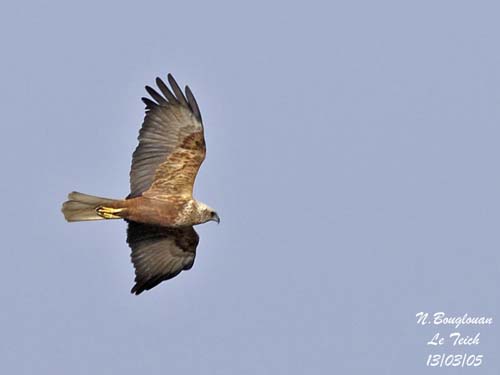
FLIGHT:
When we see the Western-Marsh-Harrier flying in profile, we can see the wings forming an open V. It flies with 4 to 5 wing beats, and then it soars at very low altitude, above the aquatic marsh and shore vegetation. But more often, it flies between 3 to 5 metres higher, alternating short beats with very raised wings, and then, much more flexibly. It flies at about 50 km/hour, being the fastest harrier in spite of its larger size.
REPRODUCTION:
Egg-laying takes place during the first days of April, in a nest built mainly by the male. Two or three weeks before the laying, the male brings nest materials and the female arranges and waves them on the reeds. When the laying is approaching, the female remains almost permanently near the nest. During this period, she is fed by the male which brings one or two preys per day, and according to the days, three to four.
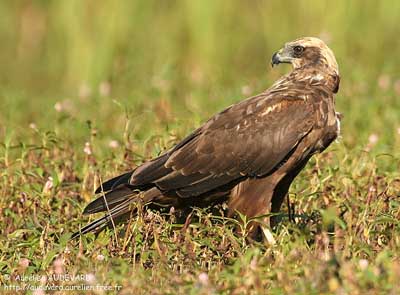
Female lays 3 to 8 eggs, at intervals of two or three days, up to five days. Eggs are bluish white, dull and often speckled with dark points. Incubation lasts about 33 to 38 days, at least 36 days for each egg. A great difference of size separates the chicks between oldest and youngest, but there is not any aggressiveness between them, and they can be successfully raised.
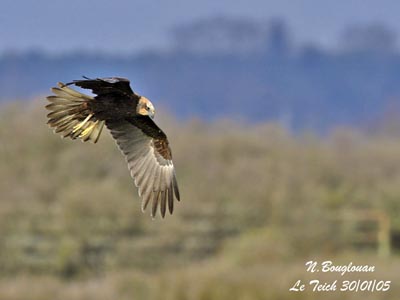
Like all young harriers, they are very aggressive when an intruder approaches, defending themselves with the claws ahead, moving the wings and opening their bills in a threatening way.
The female is very requested by chicks and rarely abandons the nest, generally in the evening if male is too late in bringing preys and does not answer its calls. The young harriers follow their parents when they are 55/60 days old, but they feed preys brought by adults, flying out of the reeds when parents approach and call them.

DIET:
The Western-Marsh-Harrier feeds primarily on frogs, but also on small mammals of the size of a young rabbit, snakes, lizards and insects. It is an important predator of water birds’ eggs and chicks.
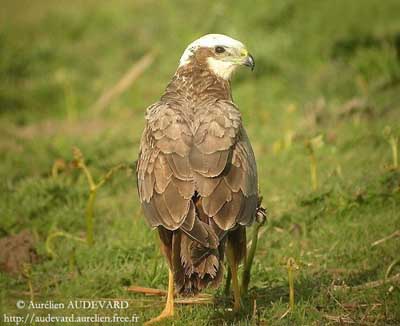
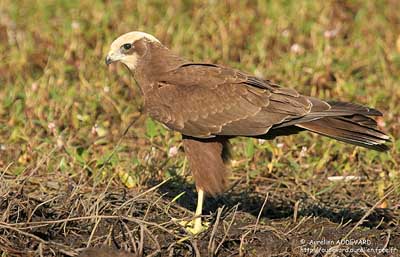
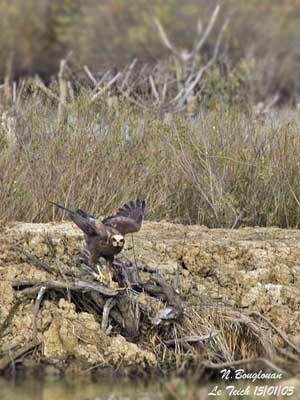
PROTECTION/THREATS/STATUS:
The populations of Western-Marsh-Harrier are threatened by habitat loss, with drainage of the wet areas and reedbeds. Destruction of the habitat involves declines in this species. Pollutions, egg gathering, poisoning, disturbances at nest and predation by foxes are other important threats.
However, the species is not threatened at this moment.
Here is (below) a beautiful observation of the Western Marsh-Harrier catching a Common Coot. This sequence illustrates perfectly the hunting behaviour of this raptor.
With the kind participation of Maurice Robert. His website: Curieux de nature?
